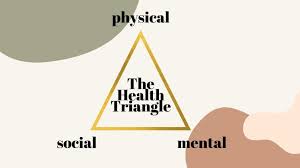What Is The Health Triangle – A Complete Guide To Physical, Mental, And Social Wellness!
Health is not just about looking fit or avoiding illness. It is a balance of different aspects of well-being that interact to influence your overall quality of life. The health triangle is a concept that helps visualize these core elements of health: physical, mental/emotional, and social. In this guide, we explore what the health triangle is, why balance matters, how to assess your own triangle, and tips for improving all three sides.
Understanding the Health Triangle:
The health triangle is a model that emphasizes the three primary components of health:
- Physical Health
- Mental/Emotional Health
- Social Health
When all three sides are equally strong and in balance, your overall health thrives. However, if one side is neglected or weakened, it affects the other two, resulting in an unbalanced health triangle.
The Three Sides of the Health Triangle:

Physical Health
This side focuses on the body’s ability to function properly and resist disease. It involves engaging in regular physical activity to keep the body fit and strong, maintaining a nutritious diet that provides essential vitamins and minerals, and getting adequate sleep to allow the body to rest and repair. Personal hygiene is also crucial in preventing infections and maintaining overall health, while regular medical check-ups help detect and address any health issues early on.
Examples of strong physical health:
- Exercising 30 minutes daily
- Drinking enough water
- Getting 7-9 hours of sleep per night
Mental/Emotional Health
Mental health involves emotional well-being and managing stress effectively. It includes self-awareness, healthy self-esteem, and coping skills to handle daily challenges. Resilience helps overcome setbacks, and seeking support when needed is key to maintaining strong mental health.
Signs of good mental health:
- Positive self-image
- Handling stress without breaking down
- Willingness to ask for support
Social Health
This side focuses on relationships and social interactions, emphasizing the importance of communicating effectively to foster understanding and trust. Respecting others creates positive and supportive connections, while building and maintaining healthy friendships strengthens emotional bonds. Actively participating in social activities helps develop a sense of belonging and contributes to overall well-being.
Traits of strong social health:
- Active involvement in community or group activities
- Supportive relationships
- Conflict resolution skills
Why Is the Health Triangle Important?
- Promotes a holistic view of health
- Helps identify areas of imbalance
- Encourages personal growth and self-care
- Prevents long-term health issues by encouraging early attention to problems
When all three areas are equally prioritized, it leads to long-term well-being, increased energy, and a more fulfilling life.
Also Read: Haven Health Phoenix – Comprehensive Skilled Nursing & Rehabilitation!
How Can Your Health Triangle Become Unbalanced?
Common Causes:
- Neglecting physical activity or sleep
- Poor diet
- Lack of emotional regulation
- Social isolation
- Excessive screen time
- Ignoring mental health symptoms
Consequences of an Unbalanced Triangle:
- Chronic stress or burnout
- Physical fatigue or illness
- Poor academic/work performance
- Damaged relationships
Real-World Example:
Imagine someone who works out daily and eats well but isolates themselves socially and never expresses their emotions. Their physical health might be strong, but mental and social health are underdeveloped—leading to an unbalanced triangle.
Can technology hurt the health triangle?
Yes, technology can hurt the health triangle if it’s not used mindfully. Excessive screen time may lead to reduced physical activity, which negatively affects physical health. Constant exposure to social media can increase stress, anxiety, and feelings of inadequacy, harming mental and emotional health. Additionally, relying too much on digital interactions instead of face-to-face communication may weaken real-life relationships, affecting social health
Factors That Influence the Health Triangle:
- Lifestyle habits (exercise, eating, sleep)
- Environment (home, school, community)
- Relationships (family, friends, peers)
- Technology usage
- Socioeconomic status
- Genetics and family history
How to Maintain a Balanced Health Triangle?

Maintaining Physical Health
Staying physically healthy involves regular exercise, ideally 3–5 times a week, to keep the body strong and energized. Eating a nutritious diet filled with fruits, vegetables, and lean proteins helps the body function properly. Drinking enough water, getting 7–9 hours of sleep each night, and avoiding harmful habits like smoking or excessive alcohol also support long-term physical well-being.
Maintaining Mental/Emotional Health
Good mental health starts with practicing mindfulness or meditation to manage stress. Expressing emotions in a healthy way, setting achievable goals, and seeking help when needed are key to emotional balance. Avoiding negative environments and harmful self-talk also plays a big role in maintaining mental clarity and resilience.
Maintaining Social Health
Healthy social life means staying connected with friends and family, joining group activities, and communicating openly. Listening actively and resolving conflicts with respect strengthens relationships. Limiting social media use and focusing on real-world interactions helps maintain genuine social well-being.
Health Triangle Assessment: A Self-Check Tool
Step 1: Assess Your Health
Rate yourself from 1–10 for each side of the triangle:
- Physical: How often do you exercise, eat healthy, and sleep well?
- Mental: Are you emotionally resilient, focused, and positive?
- Social: Do you feel connected, heard, and respected in relationships?
Step 2: Illustrate Your Triangle
Draw a triangle and make each side proportional to your score. Is your triangle balanced or skewed?
Step 3: Analyze Your Results
Look for patterns. Which side needs more attention? Are you compensating in one area due to weaknesses in another?
Step 4: Identify Strengths and Weaknesses
- Strengths: Celebrate them and maintain the habits that support them.
- Weaknesses: Set goals and find strategies to improve that area.
Building Long-Term Wellness Through Balance:
Balancing your health triangle is not a one-time event—it requires ongoing attention, adjustments, and intention. Make small changes that compound over time. Be proactive about wellness instead of reactive to crises.
Daily Practices for a Balanced Triangle
- Walk or stretch every morning
- Practice gratitude journaling at night
- Eat at least one meal with loved ones
- Avoid negative media and mindless scrolling
FAQ’s:
1. What is the health triangle in simple terms?
The health triangle is a model that shows how physical, mental, and social health work together to define overall wellness. All three must be balanced for optimal health.
2. Why do we need to balance all three sides of the health triangle?
Neglecting one side affects the others. For example, poor mental health can lower physical energy and harm relationships.
3. How can I tell if my health triangle is unbalanced?
Use a self-assessment. If one area (e.g., physical health) scores much higher or lower than others, your triangle is unbalanced.
4. Is one side of the health triangle more important than the others?
No. All sides are equally important and interconnected. You need each to live a healthy life.
5. How often should I evaluate my health triangle?
Monthly or quarterly assessments are ideal to track progress and make adjustments.
6. What activities help improve all three sides at once?
Group exercise classes, team sports, outdoor adventures with friends, or volunteering can enhance physical, mental, and social health.
7. What role does diet play in the health triangle?
Diet directly affects physical health and can influence mood (mental health) and social interactions (e.g., shared meals).
8. What should I do if I feel overwhelmed trying to balance all three sides?
Start small. Focus on improving one habit per side, like walking daily, journaling, and calling a friend weekly.
9. Can children and teens use the health triangle concept?
Absolutely. It’s a great tool to teach young people about well-being and how to develop healthy habits early.
Closing Thoughts:
Understanding and nurturing your health triangle can lead to lasting improvements in your physical, emotional, and social well-being. By identifying imbalances and actively working to strengthen each side, you’re not just surviving—you’re thriving. Use the health triangle as a visual reminder to take care of yourself fully, not just physically.
Read More:






